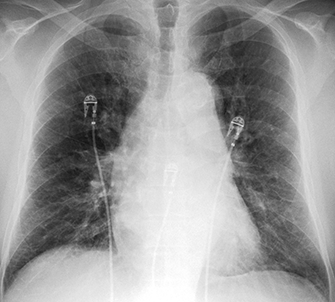A 66-year-old man comes to the office for evaluation of progressive shortness of breath for the past 2 months. The patient used to walk nearly a mile a day without difficulty. More recently, however, he feels "out of breath" and tires easily after walking a few blocks. The patient has gained 4 kg (8.8 lb) over a similar period. He has also had a persistent, dry cough that is worse at night when he is lying in bed. The patient has had no fever, chills, or night sweats. He has a history of hypertension. He is a former smoker who quit 5 years ago. Until 4 years ago, the patient worked as an engineer at a local steel mill. Temperature is 36.1 C (97 F) , blood pressure is 154/90 mm Hg, pulse is 92/min and regular, and respirations are 20/min. Pulse oximetry is 94% on room air. BMI is 47.4 kg/m2. The lungs are clear on auscultation. S1 and S2 are normal, and the point of maximal impulse is not palpable due to the patient's body habitus. The abdomen is soft and nontender. There is 1+ pretibial edema bilaterally. Initial complete blood count and complete metabolic panel are unremarkable. B-type natriuretic peptide is 95 pg/mL (normal: 100-400) . ECG shows normal sinus rhythm with evidence of left atrial enlargement. Chest x-ray is shown in the exhibit.  Echocardiography reveals concentric left ventricular hypertrophy, left atrial enlargement, and a left ventricular ejection fraction of 60%. Which of the following is the most likely cause of this patient's current symptoms?
Echocardiography reveals concentric left ventricular hypertrophy, left atrial enlargement, and a left ventricular ejection fraction of 60%. Which of the following is the most likely cause of this patient's current symptoms?
Definitions:
Temporary
Not permanent; lasting for a limited period of time or intended for short-term use.
Employer's Payroll Tax
Taxes that employers are required to pay on behalf of their employees, which may include contributions to social security, Medicare, and unemployment taxes.
Permanent
A term used in accounting to describe accounts that are not closed at the end of the accounting period, such as assets, liabilities, and equity accounts.
Q1: A 52-year-old woman comes to the office
Q47: A study assesses the length of stay
Q62: A 25-year-old woman comes to the physician
Q63: A 66-year-old man comes to a community
Q245: A 24-year-old man comes to the office
Q250: A 32-year-old woman is brought to the
Q318: A 36-year-old woman comes to the emergency
Q491: A 25-year-old woman, gravida 1 para 0,
Q1072: A 14-year-old girl comes to the office
Q1092: A 32-year-old man comes to the office